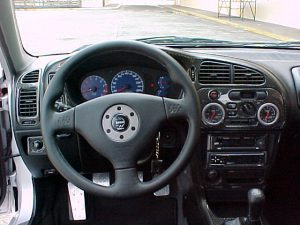How the turbo Anti-Lag System works
Bang-bang (also known as ALS which stands for Anti-Lag System) is an engine management technique that allows to minimize the turbo lag time.
As you might be aware of, turbochargers display what is known as lag time which is the time needed for the turbine to reach its full throttle from an intermediate rotational speed state. The duration of a turbocharger’s lag depends on many factors among which its inertia, airflow efficiency, back pressure, etc. The issue is partly dealt with by fitting a turbo dump valve, which acts each time the driver lifts his foot from the throttle. The dump valve will evacuate the pressurized air coming out of the turbocharger while the inlet manifold is closed thus allowing the turbine not to stall and avoiding possible damage to its bearings. In race cars it is very common to fit oversized turbochargers in order to be able to produce enough boost pressure and assure a sufficient engine output. Big turbochargers display significant amounts of lag due to their increased rotational inertia. In such cases the dump valve is insufficient to allow the turbocharger not to loose too much speed when the driver lifts off. Additionally rally cars are fitted with a turbo restrictor, which is regulated by the FIA. One of the restrictor’ effects is to increase lag time. This is why in racing cars, and more specifically in rally cars, where torque and engine availability are critical performance factors, most applications use anti-lag systems.
During lag time the engine is much less responsive and its output well below nominal. To counter the effect of the turbocharger’s lag time drivers used to anticipate the engine’s reactions by accelerating well before they would have done in a non-turbo car. Others have used a technique, introduced by the German driver Walter Röhrl, known as “left foot braking” where the driver uses his left foot to brake the car while his right foot accelerates to keep the turbocharger in optimal load. Left foot braking is very hard on the brakes which are put into extreme stress but is very efficient in keeping the turbo spinning.
ALS was a simple idea but one that was relatively difficult to implement. Only when electronic engine management systems were advanced enough to allow taking into consideration many more parameters, in real time, than in the past it became possible to use them efficiently in handling ALS. To the best of my knowledge Toyota Team Europe were the first to use it in racing (Toyota’s implementation is known as Toyota Combustion Control System while Mitsubishi call the system Post Combustion Control System).
How ALS works
When the driver lifts his foot from the gas pedal the ignition timing is altered with sometimes 40° or more of delay (retard) and the intake air and fuel supply mixture is made richer. The inlet butterfly is kept slightly open or an air injector, bypassing the inlet butterfly, is used to maintain air supply to the engine.  This results in air/fuel mixture that keeps getting in the combustion chambers when the driver no longer accelerates. The ignition being severely delayed, the air/fuel mixture reaches the exhaust tubes mostly unburned. When the spark plug fires, the exhaust valve is starting to open due to the ignition delay mentioned above. Additionally, the exhaust temperature being extremely high, the unburned fuel explodes at the contact of the exhaust tubes. Luckily the turbo sits right there and the explosion keeps it turning (otherwise it would slow down since its intake, the exhaust gases, is cut-off). The effect is vastly lower response times with some downsides:
- A quick rise of the turbocharger’s temperature (which jumps from ~800°C to the 1100°C+ region) whenever the system is activated
- A huge stress on the exhaust manifold and pipes (mounted on a street car a bang-bang system would destroy the exhaust system within 50-100 km)
- The turbo produces significant boost even at engine idle speeds
- The explosions which occur in the exhaust tubes generate important flames which can, sometimes, be seen at the end of the exhaust tube
- Reduced engine brake
The ALS effect is mostly dependent on the quantity of air allowed into the engine, the more air supplied the more the ALS effect will be noticeable. Consequently ALS systems can be more or less aggressive. A mild ALS will maintain a 0 to 0.3 bar pressure in the inlet manifold when activated whereas, when inactive, the pressure in the inlet manifold with the throttle closed would be in the region of -1 bar (absolute vacuum). Racing ALS versions can maintain a pressure of up to 1.5 bar in the inlet manifold with the throttle closed.
While the systems mounted in Toyota and Mitsubishi racing cars are relatively smooth and noiseless those fitted in Ford and Subaru cars are much more noisy and aggressive.
The bang-bang system owns its name to the loud explosion noises one hears whenever the driver lifts off. Most racing implementations have user selectable anti-lag settings depending on the terrain, usually three settings can be selected by the driver going from mild to very aggressive.
Note that some regional or national European events prohibit the use of ALS systems while more and more WRC events regulate the noise levels allowed by competition cars effectively disabling ALS.
Starting in 2002 new anti-lag techniques, such as Exhaust Gas Recirculation (EGR), are slowly overtaking the method described above as they are kinder on the engine’s mechanical parts.

